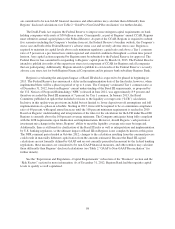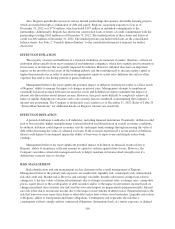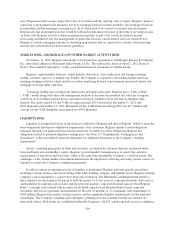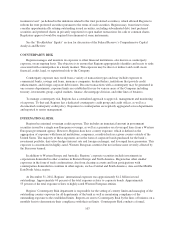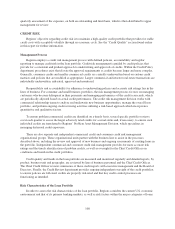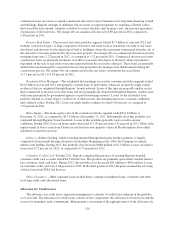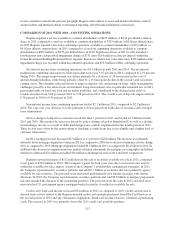Regions Bank 2012 Annual Report Download - page 120
Download and view the complete annual report
Please find page 120 of the 2012 Regions Bank annual report below. You can navigate through the pages in the report by either clicking on the pages listed below, or by using the keyword search tool below to find specific information within the annual report.rates. Prepayment risk can also impact the value of securities and the carrying value of equity. Regions’ greatest
exposures to prepayment risks primarily rest in its mortgage-backed securities portfolio, the mortgage fixed-rate
loan portfolio and the mortgage servicing asset, all of which tend to be sensitive to interest rate movements.
Regions also has prepayment risk that would be reflected in non-interest income in the form of servicing income
on loans sold. Regions actively evaluates prepayment exposure as part of its overall net interest income
forecasting and interest rate risk management. In particular, because current interest rates are relatively low,
Regions is actively managing exposure to declining prepayments that are expected to coincide with increasing
interest rates in both the loan and securities portfolios.
MARKET RISK—BROKERAGE AND OTHER MARKET ACTIVITY RISK
On January 11, 2012, Regions entered into a stock purchase agreement to sell Morgan Keegan & Company,
Inc. and related affiliates to Raymond James Financial, Inc. The transaction closed on April 2, 2012. Refer to
Note 3 “Discontinued Operations,” to the consolidated financial statements for further details.
Regions’ capital markets business, which includes derivatives, loan syndication and foreign exchange
trading activities, expose it to market risk. Further, the Company is exposed to non-trading market risk from
mortgage hedging activities which include secondary marketing of loans to government-sponsored entities and
mortgage servicing rights valuation.
To manage trading risks arising from interest rate and equity price risks, Regions uses a Value at Risk
(“VAR”) model along with other risk management methods to measure the potential fair value the Company
could lose on its trading positions given a specified statistical confidence level and time-to-liquidate time
horizon. The end-of-period 10-day VAR was approximately $521 thousand at December 31, 2012 and
$423 thousand at December 31, 2011. Maximum 10-day VAR utilization during 2012 was $1.5 million and
average 10-day VAR during the same period was $513 thousand.
LIQUIDITY RISK
Liquidity is an important factor in the financial condition of Regions and affects Regions’ ability to meet the
borrowing needs and deposit withdrawal requirements of its customers. Regions intends to fund obligations
primarily through cash generated from normal operations. In addition to these obligations, Regions has
obligations related to potential litigation contingencies. See Note 23 “Commitments, Contingencies and
Guarantees” to the consolidated financial statements for additional discussion of the Company’s funding
requirements.
Assets, consisting principally of loans and securities, are funded by customer deposits, purchased funds,
borrowed funds and stockholders’ equity. Regions’ goal in liquidity management is to satisfy the cash flow
requirements of depositors and borrowers, while at the same time meeting the Company’s cash flow needs. The
challenges of the current market environment demonstrate the importance of having and using various sources of
liquidity to satisfy the Company’s funding requirements.
In order to ensure an appropriate level of liquidity is maintained, Regions performs specific procedures
including scenario analyses and stress testing at the bank, holding company, and affiliate levels. Regions’ holding
company cash is managed to a conservative three step evaluation. The Minimum Cash Requirement utilizes a
three step process that requires the parent to hold the greater of 1) two years of corporate dividends, debt service,
and maturities by utilizing cash on hand, and the next four quarters’ expected dividend capacity from Regions
Bank, 2) enough cash on hand with no upstream dividend capacity from Regions Bank to meet corporate
dividends, debt service payments and maturities for the next 12 months, or 3) a minimum cash requirement of
$500 million. Regions runs similar testing scenarios and has minimum liquidity requirements for the bank and
subsidiaries. The Company’s funding and contingency planning does not currently include any reliance on
unsecured sources. Risk limits are established within the Company’s ALCO, which regularly reviews compliance
104






